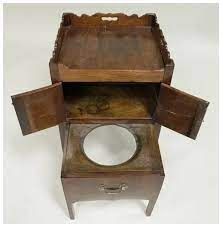So my first thought was that it’s not a table although, apparently, the bedside table is practically synonymous with a nightstand, a multi-purpose mini-cabinet, as opposed to just a surface. The history of nightstands go back to the medieval era in Europe. Known as a commode, the earliest forms were not small tables but compact cabinets with doors and storage space. These original commodes were used to house chamber pots or washbasins, essential items in an era before indoor plumbing.
Because chamber pots carried certain odours with them, the finer elements of society needed some way to store them. Furniture designers at the time devised the commode as a small side table to place the chamber pot in at night. The original purpose of the nightstand, then, was purely functional. So that cupboard in my bedside table is where the chamber pot would have stood.
Even before the chamber pot became obsolete, the design of the commode had begun to change. The 18th and 19th century upper classes, from France to the United Kingdom to the United States, ordered pieces that furthered disguised the nightstand’s purpose with elegant forms and beautiful features.
The 20th century marked a period of development in design. The advent of electricity changed the function of bedside tables once more, with spaces designed to accommodate lamps and, later, alarm clocks. The Art Deco movement of the 1920s and 1930s led geometric forms and exotic materials defining the designs of the era. Further developments in the 1940s onwards have led to the position now where they serve as a spot for books, lamps, alarm clocks and, surprisingly to me, house charging docks for digital devices.
 |
| a pair of 1920s Art Deco bedside tables |
I was going to expand a bit on the above but I came across the following by Jenny Smith, the senior editor of Povison:
‘Incorporating Feng Shui principles into your bedroom can significantly impact your overall well-being, and the bed table plays a crucial role in this ancient practice. According to Feng Shui, the nightstand, commonly known as a bed table, should be positioned on either side of the bed for balance and harmony. Ensure both nightstands are of equal size and height to promote equality and create a sense of unity in your sleep space.
The items you place on your nightstand can influence the Feng Shui of your bedroom. Avoid electronic devices, especially near your head, as they can disrupt the natural energy flow and potentially interfere with your sleep. Sharp objects, such as scissors or knives, are discouraged due to their association with cutting energy. Instead, opt for soothing items like a book, a small potted plant, or calming crystals to enhance positive energy and promote a serene atmosphere.
Feng Shui places emphasis on balance and symmetry, extending to the height of your nightstand. Ideally, the nightstand should be level with the height of your mattress. This creates a harmonious visual line, promoting a sense of equilibrium in the bedroom.
Understanding what constitutes bad Feng Shui in the bedroom is vital for cultivating a harmonious and restful environment. Avoid placing the bed in direct alignment with the bedroom door, as it is believed to result in disturbed sleep and energy imbalance. Additionally, steer clear of clutter under the bed, as it can disrupt the energy flow and create stagnation. Mirrors facing the bed are also discouraged, as they are thought to bounce energy and impact the quality of your sleep.’
Make of that what you will.
I’ve only got one poem that mentions a bedside table:
4 am
sheets
cold tea
on a bedside table
silence
4 am
sheets
cold tea
on a bedside table
silence
Terry Quinn



1 comments:
Your bedside table sounds delightfully colourful. Thanks for the research into the origins of nightstands et al. Of course, I'm not convinced by Feng Shui, but I'm all in favour of equilibrium in the bedroom. It's a poignant little poem. Well done.
Post a Comment